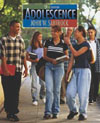1. Adolescents who come from severe poverty, who experience parental divorce, who are the subjects of discrimination, and who attend very poor schools are "at risk" for various psychological and behavioral disorders. Yet, it is not at all inevitable that those who are "at risk" will experience poor development. How do they develop the resilience that insulates them from the negative environmental conditions? http://www.aic.gov.au/publications/tandi/tandi183.html 2. Rites of passage mark important developmental milestones. Some are more formal, for example, a religious ceremony, and others are less formal, for example, entrance into sexual behavior. How might you use the concept of rites of passage to explain various aspects of adolescent behavior (e.g., body piercing, tattooing) to high school teachers? http://www.dtmms.org/rites-of-passage/index.htm 3. The multicultural model of cultural change promotes a pluralistic approach to meeting common needs. As a student in higher education, how would you explain the role of education, and particularly multicultural education, in achieving this form of cultural change? http://curry.edschool.virginia.edu/go/multicultural/papers/keith.html | 


 2003 McGraw-Hill Higher Education
2003 McGraw-Hill Higher Education

 2003 McGraw-Hill Higher Education
2003 McGraw-Hill Higher Education